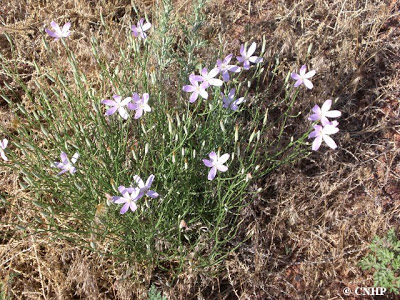Note – Jude Sirota, Mesa County Weed and Pest Inspector, sent us this update on how she and her contractors have modified their weed control procedures to accommodate rare plants in the area. Thank you Jude, we really appreciate it!
By Jude Sirota
Weed and Pest Inspector, Mesa County Division of Pest Management
Two lonely dirt roads parallel the Dolores River north of Gateway, Colorado. Along these two roads a rare native plant grows, Dolores River skeleton plant (Lygodesmia doloresensis). It somehow persists in the face of road maintenance — blading, erosion and routine maintenance — and it grows alongside a state-listed noxious weed and growing menace, Russian knapweed (Acroptilon repens).

While on a tour of the area with the Nature Conservancy and the Colorado Natural Heritage Program, I learned about this scraggly, delicate, yet durable native. I was disheartened to see it growing within 6 inches of invasive knapweed plants, which I was responsible for treating on county roads. I promised Susan, Peggy, and Betsy that I would do my best to prevent the demise of their beloved plant.
The county contractor was due to spray the roads for knapweed in mid September and had been warned that there was a rare plant in the area. On September 9th Casey Holman, a seasonal crew member, and I traveled to Gateway with spray and garbage bags in hand. We drove up and down the dusty back roads until we found a skeleton plant. If there was knapweed growing within 30 feet of the native, we gently wrapped the Lygodesmia in a plastic garbage bag, all the way down to the soil, secured the bag with rocks, and treated the nearby knapweed with an herbicide. After uncovering the Lygodesmia, we placed orange flags with a big black “R” on them up and down the road from the patch so that the contractor would know to avoid spraying those patches.
On the drive back to the office, we felt good knowing we had done our part to protect a rare native plant. It was somewhat painstaking and may have seemed ridiculous to a passer-by, but I’m confident that our efforts will eradicate the knapweed (at least in a local sense) and reduced the threat to the native plants.




